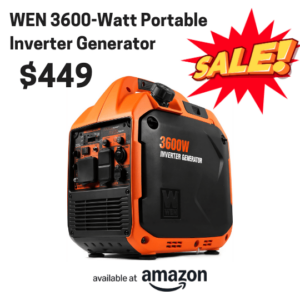A well-sealed RV roof is crucial for preventing water damage and maintaining the longevity of your rig. But let’s be honest—nobody wants to spend their precious time frequently resealing the roof. That’s why choosing a high-quality sealant is essential to minimize maintenance efforts. In this guide, we’ll explore the best RV roof coatings and sealants in 2023, ensuring you get the most effective and long-lasting protection for your RV.
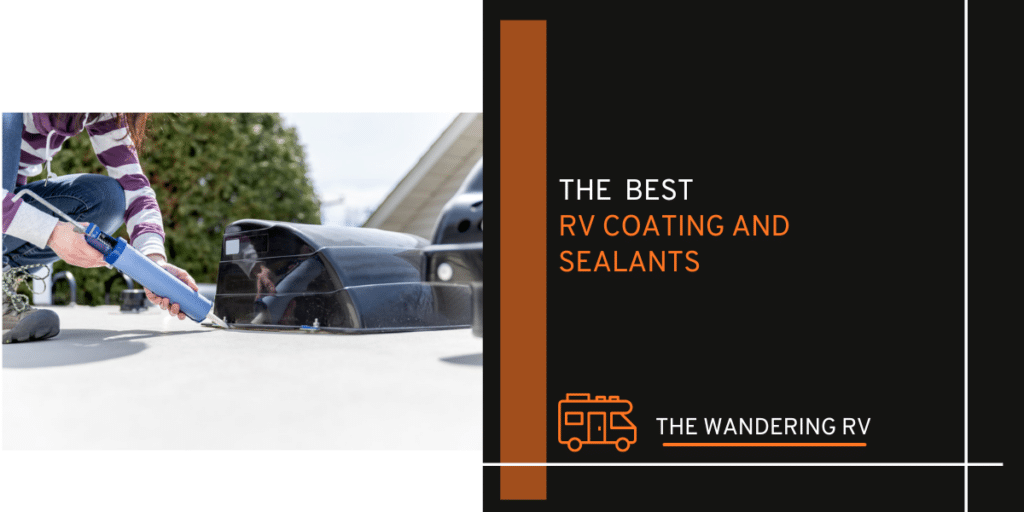
Table of Contents
- Best RV Roof Coating & Sealants of 2023
- Types of RV Roof Sealant & Coating
- Best RV Roof Sealant Brands
- Camper Roof Sealant & Coating Pricing
- How To Reseal Your RV Roof
- Benefits of Sealing Your RV Roof
- FAQs
- Conclusion
The Dyrt Camping App
- Find free camping with a public lands map
- Up to 40% off select campgrounds
- First 30 days free with code “TWRV”

Note: Some of the links in this article are affiliate links. This doesn’t cost you any more than normal. Read our disclaimer for more info.
Best RV Roof Coating & Sealants of 2023
While there are many roof coating and sealant products on offer, there are a few options that stand out. Below are the three best RV roof coating & sealants of 2023.
Best Overall
Heng’s Rubber Roof Coating
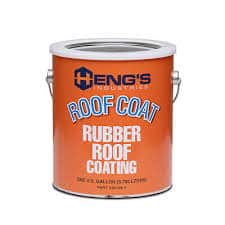
Summary
If you’re an RV owner looking for an excellent roof coating product, you can’t go wrong with Heng’s Rubber Roof Coating. One of the main reasons it’s become the go-to roof coating for most RV owners is its high-quality formula.
Pros
- Easy to work with
- Non-toxic, non-polluting
- Perfect if you want to seal up tears and cracks
- Stands up well to UV rays
- Can expand and contract in the heat
- Ensures your RV’s roof integrity is never compromised
Cons
- Isn’t as durable as other product options
- Needs re-coating after every few years
Best Value
Dicor EPDM Self-Leveling Sealant
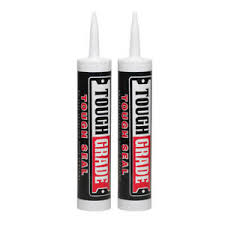
Summary
This RV roof sealant is perfect for fixing cracks, sealing vents, and covering screw heads and is one of the best selling products.
Pros
- Very easy to use
- Works well with most RV roof surfaces, including TPO and EPDM sheeting
Cons
- Have to buy several of them if you intend to seal your entire RV roof as it comes in quite a small tube
Honorable Mention
Flex Seal Liquid Rubber in a Can
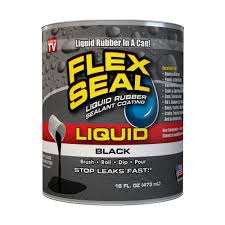
Summary
This product’s strength is its versatility. It enables you to not only seal your RV’s roof but other areas around your motor home as well.
Pros
- Non-flammable
- Stands up to UV rays, chemicals, corrosion, and rust
- Easy to apply
Cons
- Need to apply at least three coats for the product to be fully effective
Best UV Resistance
EternaBond RSW-2-50 RoofSeal
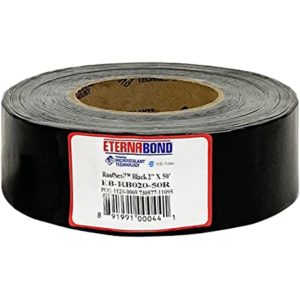
The EternaBond RSW-2-50 RoofSeal is the first non-liquid sealant on this list. This product is an expandable tape that is just as effective a sealant as the liquid options mentioned above. The tape implements MicroSealant Technology, which is made up of synthetic resins, thermoplastics, and non-curing rubber with an integrated primer. Additionally, the RSW-2-50 RoofSeal tape has a high elongation factor, allowing it to easily expand and contract depending on the environment’s changes without impeding its adhesiveness. If that wasn’t enough, the tape is also UV-stable, and its white finish helps it reflect sunlight. When applying the tape, clean your roof’s surface, remove the tape’s silicone line, and prevent the tape from sticking to surfaces you don’t wish to seal.
Pros
- Capable of reflecting sunlight
-
Can expand and contract in different conditions
-
Can withstand UV rays
Cons
- If applied during wet, damp, or icy conditions, the product can trap water beads
- Frequent exposure to sunny conditions could make the tape wrinkle or lose color
-
Best Elasticity
Rubberseal Liquid Rubber Protective Coating
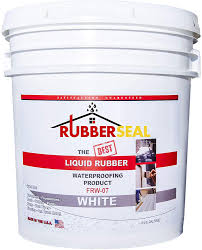
We are back to liquid coating and sealant products with the Rubberseal Liquid Rubber Protective Coating, which you can use on any roof that needs protection, including your RV’s roof. This rubber sealant cures into a coating of expandable acrylic that doesn’t crack easily, protecting your roof from UV rays, rain, snow, and extreme weather. The sealant is also resistant to moisture and can help regulate your RV’s indoor temperature. Additionally, because it is a water-based formula with a low rating for unstable mixtures, the product will not cause the application surface to break down too quickly. The sealant can also retain its flexibility for much longer than some of the other products.
Pros
- Can be used on all roof types
-
Comes in various thicknesses and strengths
-
Waterproof
-
Can expand and contract in different conditions, retaining its elasticity for an extended period
-
Does not crack easily
-
Can withstand chemicals, extreme weather, moisture, and UV rays
-
Can help control your RV’s ambient temperature
-
Easy to apply
-
If combined with an activator or cleaner, you can further improve its adhesiveness
Cons
- Might need multiple applications
-
Easily takes on dirt
-
If applied in poor weather, it might be porous and could even leak whenever it rains
-
Might have to peel it off if it gets too discolored
Best Warranty
KST Coating Elastomeric Finish Coat
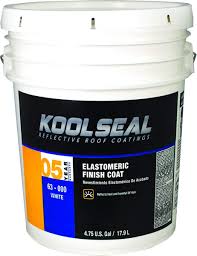
The KST Elastomeric Finish Coat is a white resin coating that seals leaks on your camper’s roof by curing into a rubber-like coat. It can expand and contract with the material you apply it on and is the perfect coating solution if you reside in highly humid conditions. The coating can retain its adhesiveness even in harsh weather conditions, maintaining its flexibility even in temperatures of up to 160 degrees. The product can also resist up to 90% of UV rays.
Pros
- Offers protection against soap, algae, mildew, and moisture
-
Expands and contracts with your RV’s roof
-
Retains its adhesiveness and flexibility even in the most extreme conditions
-
Has a seven-year warranty from the manufacturer
Cons
- Because the product dries into a coat thinner than other similar products, it might not offer the same durability levels
-
May need at least two coats to improve its effectiveness
-
Could start flaking after some time
Best Leak Prevention
ToughGrade Self-Leveling RV Lap Sealant

The ToughGrade Self-Leveling RV Lap sealant is a product that protects your roof from discoloration, sun damage, and the development of leaks. The product is specifically designed for rubber roofs and horizontal surfaces as it self-levels to seal cracked surfaces effectively. However, you can use it to seal various surfaces such as vent covers, vent pipes, screw heads, air vents, and other types of material like galvanized metal, concrete, vinyl, aluminum, and wood. Thanks to its stabilized formula, the product can protect your roof from harmful UV rays, reducing the risks of deterioration and discoloration. The sealant can withstand harsh weather conditions and extreme temperatures without peeling. It also will not freeze if you expose it to snow. On top of that, the product is easy to work with, dries pretty quickly, and you can even paint over it.
Pros
- Does not peel even when exposed to harsh weather and extreme temperatures
-
Extremely easy to apply
-
Dries quickly
-
Can be painted over without damaging it
-
Can be used on various surfaces and materials
-
Resistant to discoloration and sun damage
Cons
- Can only be used on horizontal surfaces
-
At times, it might not self-level as well you expect or need
-
Off-white color may affect the aesthetics of a white RV roof
Types of RV Roof Sealant & Coating
For you to enjoy these and more benefits, it is essential to get the right coating for your RV’s roof. One way to ensure you do that is by familiarizing yourself with the several different roof sealants and camper roof coatings available on the market.
Below are some of the different types that you can get.
Urethane Coating
This type of coating is suitable for off-road use, offering adequate protection against impact from small debris like falling branches. It also has good UV resistance and prevents water from pooling on your roof. The coating is reflective and more durable than some of the other coating options.
One downside, however, is its high price. Additionally, it needs a minimum of two coats to work effectively and often gives off a strong, unwanted smell during installation.
Acrylic Coating
An acrylic coating is perfect if you are looking for a reliable coating on a limited budget. It provides decent performance, leak protection, and reflectivity. The coating is also resistant to UV rays.
Some of the drawbacks of this coating, however, include its limited durability. Its ineffectiveness at handling ponding water could also cause the coating to peel or degrade, eventually leading to leaks. You will also need to apply two coats for it to be fully effective.
Silicone Coating
Though silicone coating is slightly more expensive, its numerous benefits make the initial investment worth it. Unlike an acrylic coating, silicone only needs one coat, which could reduce your roof coating project’s overall cost.
A silicone coating is also highly durable, resistant to ponding water and weather damage, and has high reflectivity. It can stay elastic for long periods, becoming neither too brittle nor too hard quickly.
One drawback of this coating type is that it tends to get dirty quickly, though occasionally washing your rig will resolve such issues.
Best RV Roof Sealant Brands
Depending on the type of coating and sealant you are looking to get, there are a few go-to brands amongst RV owners, including Dicor Products and Liquid Rubber. Here are some more details about each one.
Dicor Products
Dicor Products has been operating for close to 40 years, not only making sealants and coatings but making everything you will ever need to maintain your RV as well. On top of that, the company is continuously improving its products.
When it comes to RV roof coatings and sealants, some of the company’s best-selling products include the Rubber Roof Acrylic Coating and the EPDM Self-Leveling Lap Sealant.
Liquid Rubber
This Canadian company makes several different RV coating and sealant options, with its most popular product being its liquid roof coating formula.
The company manufactures high-standard products, ensuring that all its customers get quality products, including the Brilliant White RV Roof Coating and Sealant.
Camper Roof Sealant & Coating Pricing
Different factors determine the pricing of a coating or sealant product. These factors range from the type of sealant and coating you want to the product’s packaging size. Other product features that dictate price include the product’s formula, durability, water repellency, UV resistance, and ease of application.
When trying to determine which product to go for, it all comes down to your needs. However, one key consideration you will have to make when shopping for your desired sealant and coating product is its quality.
You could get the most basic products for under $15, with high-end options often costing you more than $40. You also have the option of going for a mid-range choice whose pricing falls typically between the $15 and $40 margin.
Expect to pay more if you intend to hire a professional to apply the coating for you. Most professional RV dealerships charge between $1,500 and $2,000 for the total sealing of your RV’s roof. The difference in pricing depends on the type of sealant you are using and your RV’s roof condition.
Such prices can, understandably, be on the high side for some RV owners, with many of them opting to purchase and apply the sealant and coating themselves.
Related Post — 7 Best RV Recliners in 2023 (Review & Guide)
How To Reseal Your RV Roof
If you intend to reseal your RV roof yourself, it is essential that you do it the right way; otherwise, the sealant and coating will not be fully effective. Fortunately, the process is easy to do. Here is a step by step guide on how you can reseal your RV roof.
1. Start by thoroughly cleaning your roof, getting rid of all the dust and dirt particles. Once your RV’s roof is clean, proceed to dry it thoroughly.
2. After that, scrape off any additional debris. Remember to take extra caution when scraping and ensure that you do not elongate any present tears or punch a hole on your roof. Once this is complete, you can now proceed to apply the sealant. Ensure that the sealant you use is compatible with your RV’s roof.
3. While wearing gloves, evenly apply the sealant and coating on your roof using a paintbrush or trowel. Make sure that you seal anything sticking through the roof of your RV, such as antennas and vents. Doing this is vital because such areas can quickly develop leaks that gradually damage your RV’s interior. Also, make sure that you coat the seams, covering all of them and not just the damaged areas.
4. If you discover a rip or tear in your RV roof, we advise you to purchase fiberglass repair tape to patch it more thoroughly. Do this by spreading your sealant over the torn or ripped area, and then place a piece of tape over the damaged patch. After that, apply sealant once more to cover that area adequately.
Benefits of Sealing Your RV Roof
Sealing your RV’s roof is a vital part of RV maintenance. Regularly doing so helps protect your roof, its features, and, ultimately, your entire RV.
The sealing process will vary depending on your roof’s material type and the sealant you use. However, sealing your roof offers you several crucial benefits such as structural protection, reducing wear and tear, preventing leaks, extending your roof’s lifespan, regulating internal temperature, reducing energy use, and saving money.
Offers Structural Protection
Sealing your RV’s roof prevents the development of cracks or seals the ones that have occurred, helping you to protect your RV’s structural integrity. The structural protection a quality sealant provides you with goes a long way in avoiding costly roof repairs.
Reduces Wear and Tear
Your RV’s roof has to withstand a lot of harsh conditions, which, over time, can easily lead to wear and tear. Regularly coating or sealing your roof helps to reduce this wear and tear, keeping your roof in optimal condition for much longer.
Even if damage occurs, all you will probably need to do is reapply a new coating layer, which is quicker, cheaper, and easier than taking your RV in for repairs.
Helps To Prevent Leaks
Leaks can easily ruin your RV’s interior, damage the installation, cause discomfort, and create considerable inconvenience. Sealing your roof helps prevent leaks from damaging the roof and the RV’s interior, keeping your interior safe and saving you from worry and costly repairs.
Extends Your RV’s Roof Lifespan
Regularly coating or sealing your roof protects it from all the external factors that affect its condition and performance, such as dirt, sleet, UV rays, rain, snow, and more. Protecting your roof from all these external factors goes a long way in extending your roof’s lifespan.
Helps to Regulate Your RV’s Internal Temperature
The protective barriers that the coating forms can also help regulate your RV’s internal temperature, helping you keep the indoor climate warm during the winter and cool during the summer.
Reduces Your Overall Energy Use
As the coating regulates temperature, you are more likely to use less energy to keep yourself warm during the winter or cool during the hot summer days. The less energy you use, the more money you save.
Saves You Money
While getting a quality RV roof coating product can initially cost you a lot, keeping your roof in the best possible shape ends up saving you more money in the long run because you get to spend less on roof maintenance.
FAQs
Maintaining your RV’s roof is a never-ending process that can become challenging for many. To help you along the way, here are answers to a few frequently asked questions.
How long does an RV rubber roof last?
Different RVs could be fitted with different types of roofs, including rubber. While your rubber roof’s lifespan heavily depends on how you maintain it, they tend to last for anywhere between 10 and 12 years.
However, if you care for it properly, you can get up to 20 years of service from your roof before needing to replace it entirely.
What type of RV roof do I have?
Besides rubber, there are other types of roofs with which your RV could be fitted. Knowing the type of roof your RV has is the first step in determining the kind of maintenance efforts it needs.
There are three common types of material used in most RV roofs. They include rubber, fiberglass, and metal.
Rubber is the most common material being used today. Such roofs are made from a specific type of rubber known as Ethylene Propylene-Diene Monomer, or EPDM for short. Though it might sound unfamiliar, the material feels and looks just like the regular rubber you have come across before.
Here’s how to know if your RV’s roof is made of rubber:
- Rubber RV roofs are the only kind of roofs that are soft
- Newer rubber roofs are entirely white, while older ones tend to either be off-white or tan
- In older rubber roofs, the texture tends to be chalky as a result of the rubber wearing down
Though they are not as common as rubber roofs, metal roofs are the easiest type of roof to identify. Here is what to look for in metal RV roofs:
- A silver or shiny metallic look
- All metal roofs have support beams often placed after every 2 feet because the thin, flexible metal is unable to support a lot of weight by itself
Last but not least, we have fiberglass roofs. These types of roofs are becoming rarer by the day. They also happen to be the most difficult to identify because they implement a wide variety of styles.
Fortunately, all fiberglass RV roofs have similar characteristics that make it possible for you to identify them. Here are some of the common ones:
- Fiberglass roofs are the most solid and hardest type of roof used in RVs, feeling different to the touch when compared to rubber and not as flexible as metal roofs
- These types of roofs are also very smooth and tend to be quite slippery when wet
How do I maintain an RV rubber roof?
Being the most common type of roofing used on most RVs, chances are your RV is fitted with a rubber roof. While every type of roof needs regular maintenance, the steps differ depending on the type of material used.
Let’s look at the ways you can maintain your RV’s rubber roof:
- Apply a quality coating and sealant product on all the cracks and seams to provide your roof with the protection it needs
- Apply a rubber roof cleaner to remove chalking, repeating this action at least three times every year to limit future chalking and repel moisture
- Avoid parking under trees that drop debris or sap because they could damage your roof and often make cleaning your roof much more challenging
- Periodically inspect your roof for tears, rips, caulking separations, and cracks, addressing possible damage early on
- Clean your roof at least twice every year (more on this below)
When cleaning your roof, be sure to avoid citric cleaners, abrasive cleaners, or any product that utilizes a petroleum distillate. Cleaning your roof can also be a dangerous task so ensure you take all the necessary precautions beforehand.
These are the steps you should follow when cleaning your rubber roof:
- Sweep away all the loose debris, paying more attention to areas around your roof’s fixtures
- Inspect your roof for loose, crumbling, or old sealant, removing it with a medium bristle brush and a scraper
- Next, rinse your roof with a hose, also hosing off your RV’s front and sides to prevent streaks from forming as you clean your roof
- Take your bucket and fill it with soap and water, scrubbing your roof with a medium-bristled brush or a long-handled mop
- Utilizing a circular motion, clean your roof one section at a time as you look for tears and rips in your roof’s material in the process
- If your roof has more stubborn stains like sap, mold, or mildew, you could use cleaners specifically designed to clean rubber roofs
- Rinse the roof and leave it to dry
- For added protection, consider reapplying a high-quality sealant or coating if you deem it necessary
Conclusion
Protecting your RV roof is a critical aspect of RV maintenance, and investing in the best roof coating or sealant is a smart decision. We hope our guide to the 7 best RV roof coatings and sealants in 2023 has provided you with the information you need to make an informed choice. With the right product, you can enjoy peace of mind knowing your RV is well-protected from water damage and ready for the open road.
Other RV Buying Guides:
- Must-Have RV Accessories, Supplies & Parts
- RV Refrigerators
- RV Air Conditioners
- RV Water Pumps
- RV Antennas
- RV Recliners
- RV Roof Coating & Sealants
- RV Leveling Blocks
- RV Batteries
- Best Portable Grills
- RV Water Filters
- RV Surge Protectors
- RV Generators
- RV Mattresses
- RV Backup Cameras
- Portable Toilets
- Portable Camp Sinks
- Camp Chairs with Canopy
- RV Covers
- RV WiFi Boosters


